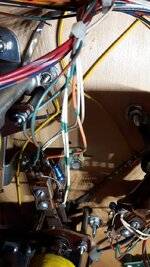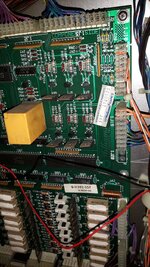When I power on my Bk2k it warms me of a fault with stitch 21 which is the lower pop bumper. Subsequently that pop bumper has stopped firing.
I've checked for any wires that may have come loose, and checked both wires (orange/green, and green/orange)that relates to that switch along the other switches in the column and row. Even checked between switches for continuity on those wires with multimeter and all seems OK.
I've checked operation of the section of switch that 21 relates to with multimeter and it shows on when I push the skirt down.
The pop bumper coil works fine as I tried powering it from one of the other bumpers power cables, and it fief perfect every time.
I have noticed what looks like a capacitor across one of the sets of contacts has a leg broken off. I tested one of the other bumpers by removing the capacitor to see if it made a difference and that bumper still fired fine without it.
Finally I checked continuity between the contacts that have the capacitor soldered to them. On the 2 bumpers that work my multimeter says no connection. On this bumper that isn't working and snapped capacitor it says there is continuity between those contacts which seems strange. I'd have thought the results would be the other way round.
Could it be a transistor that has died on the controller pcb causing this fault and the odd continuity results across those contacts?
I've checked for any wires that may have come loose, and checked both wires (orange/green, and green/orange)that relates to that switch along the other switches in the column and row. Even checked between switches for continuity on those wires with multimeter and all seems OK.
I've checked operation of the section of switch that 21 relates to with multimeter and it shows on when I push the skirt down.
The pop bumper coil works fine as I tried powering it from one of the other bumpers power cables, and it fief perfect every time.
I have noticed what looks like a capacitor across one of the sets of contacts has a leg broken off. I tested one of the other bumpers by removing the capacitor to see if it made a difference and that bumper still fired fine without it.
Finally I checked continuity between the contacts that have the capacitor soldered to them. On the 2 bumpers that work my multimeter says no connection. On this bumper that isn't working and snapped capacitor it says there is continuity between those contacts which seems strange. I'd have thought the results would be the other way round.
Could it be a transistor that has died on the controller pcb causing this fault and the odd continuity results across those contacts?




